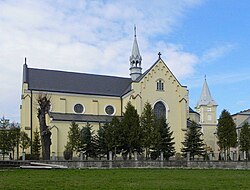Oleszyce
Oleszyce | |
|---|---|
 Church of the Nativity of the Virgin Mary | |
 Coat of arms | |
 Oleszyce | |
| Coordinates: 50°10′1″N 23°1′51″E / 50.16694°N 23.03083°ECoordinates: 50°10′1″N 23°1′51″E / 50.16694°N 23.03083°E | |
| Country | |
| Voivodeship | |
| County | Lubaczów |
| Gmina | Oleszyce |
| Government | |
| • Mayor | Andrzej Gryniewicz |
| Area | |
| • Total | 4.98 km2 (1.92 sq mi) |
| Population (2006) | |
| • Total | 3,168 |
| • Density | 640/km2 (1,600/sq mi) |
| Time zone | UTC+1 (CET) |
| • Summer (DST) | UTC+2 (CEST) |
| Postal code | 37-630 |
| Car plates | RLU |
| Website | http://www.oleszyce.pl/ |
Oleszyce [ɔlɛˈʂɨt͡sɛ] (Ukrainian: Олешичі, Oleshychi) is a small town in Subcarpathian Voivodeship, Poland, with 3,089 inhabitants (02.06.2009).[1]
History[]
The history of Oleszyce dates back to the early 15th century, when the village belonged to Poland's Ruthenian Voivodeship. It was first mentioned in documents from 1431, as Heleschicze; its name was also spelled as Olieschicze, Oleczyce and Olessicze, and probably comes from male name Olech or Olesz. In 1458, a wooden Roman Catholic parish church was built here by the Ramsza family, owners of the village.
In 1570, Oleszyce became property of Voivode of Ruthenia, , who in 1576 established here a town named Hieronimow, based on Magdeburg rights. The town was located between the already existing village, and a manor house, and its charter was confirmed by King Stefan Batory on February 26, 1578. The name Hieronimow was seldom used, and by mid-17th century, disappeared, replaced by ancient name Oleszyce.
In the mid-17th century, Hieronimow/Oleszyce had 107 houses and over 1000 residents, with Catholic and Orthodox churches. In the early 18th century, Oleszyce became main center of properties of the noble Sieniawski family: here, in 1706, a secret meeting between Crown Hetman Adam Mikolaj Sieniawski and Saxon envoy named Spiegel took place.
Across centuries, Oleszyce was frequently raided and destroyed by Crimean Tatars (1498, 1624, 1672), Zaporozhian Cossacks (1610, 1629, 1648), burned in fires (1710, 1726), its population was also decimated by plagues (1626, 1641).
In 1731, Oleszyce became property of the Czartoryski family. After the Partitions of Poland, the town belonged to Austrian Galicia (1772–1918), but remained private property of the families of Dzialynski, Potocki, Potulicki and Sapieha. In 1880, Oleszyce lost its town charter.
In the Second Polish Republic, Oleszyce was part of Lwow Voivodeship. In 1938, its population was 3500, divided between Poles (920), Ukrainians (860), and Jews (1700). The village was captured by the Wehrmacht on September 12, 1939. A few days later, heavy fighting between the advancing Germans and retreating Polish 21st Mountain Infantry Division took place in the area of Oleszyce, in which General Jozef Kustron was killed (September 16).
German presence in Oleszyce was short, as on September 20, the village was occupied by the Red Army. On 15 November, Oleszyce was annexed to the Soviet Union as part of the Ukrainian SSR, and German-Soviet boundary was established a few kilometers north of the village (see also Molotov–Ribbentrop Pact). In June 1941, the NKVD murdered a number of prisoners, kept in the local castle (see NKVD prisoner massacres). In November 1942, the Germans displaced more than 2.000 Jews from Oleszyce to the Lubaczow ghetto, established on October 8, 1942. According to one source, about 1.000 of these Jews were sent to the Belzec death camp before the end of November. After the liquidation of the Lubaczow ghetto in January 1943, many Jews ran away and went into hiding in Oleszyce and its surroundings. From January until March 1943, more than 127 Jews from Oleszyce and neighboring villages were executed in the Jewish cemetery.[2]
After World War II, the village and its area was affected by the activities of the Ukrainian Insurgent Army, which in the night of September 5/6, 1945, attacked Oleszyce with the rail station. Ukrainian nationalists were defeated by Polish Army battalion, but before that happened, they managed to burn down several houses.
Notable people[]
- Eva Galler, Jewish Holocaust survivor
References[]
- Notes
- ^ "Population. Size and structure by territorial division" (PDF). © 1995–2009 Central Statistical Office 00-925 Warsaw, Al. Niepodległości 208. 2009-06-02. Retrieved 2009-06-22. External link in
|publisher=(help) - ^ "YAHAD - IN UNUM". yahadmap.org. Retrieved 2017-07-15.
- Cities and towns in Podkarpackie Voivodeship
- Lubaczów County
- Kingdom of Galicia and Lodomeria
- Lwów Voivodeship

